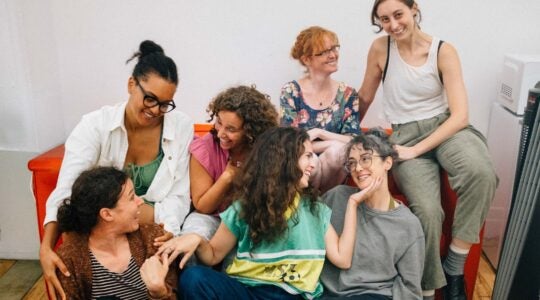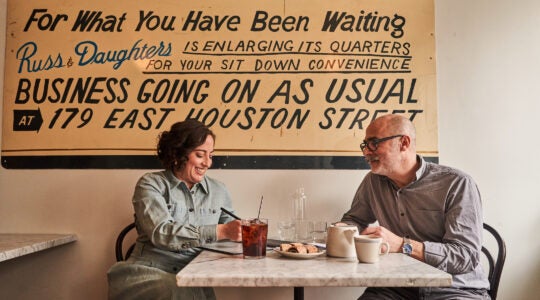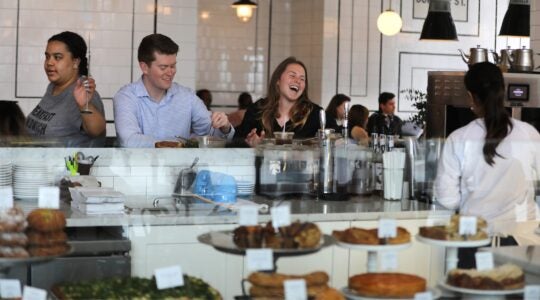In a sign of the demographic changes rippling through the Lubavitch stronghold of Crown Heights, a new eruv fight is pitting Jew vs. Jew.
Observant Jew vs. observant Jew, that is.
As more and more Modern Orthodox Jews move into the area, one that for years has been home to the Chabad-Lubavitch chasidim, the eruv battle is revealing the emerging fault lines in the neighborhood. Those divisions, however, are in stark contrast to ones seen in other eruv battles, which generally pit Orthodox vs. liberal Jews and center around “character of the neighborhood” issues.
In Westhampton Beach, on Long Island’s East End, locals, including a group called “Jewish People for the Betterment of Westhampton Beach,” vehemently opposed the 2008 proposal to construct an eruv, with many opponents saying they feared an influx of Orthodox Jews into the area. That battle stretched over eight years, with lawsuits in both state and federal courts, before eruv opponents decided to drop the fight in March.
In 2000, the eruv association in Tenafly, N.J., filed a federal lawsuit charging discrimination after its borough council voted against a proposed eruv. At public hearings on the issue, many people, including Jews, said they feared an influx of Orthodox Jews would change the “character” of the community. The court sided with the eruv association in 2002, but the borough took the case all the way to the U.S. Supreme Court, which, in 2003, turned down its petition to review the case.
The Crown Heights eruv controversy is not being fought in the courts, but rather over social media.
It exploded on Facebook last weekend as the new ritual enclosure was about to be used for the first time. The eruv, which was built privately, is a boon to members of Congregation Kol Israel, a largely Modern Orthodox shul founded in 1924. It increases sixfold the area in which observant Jews can carry items, and, most importantly, push strollers during Shabbat. According to Jewish law, Jews cannot carry (or push) anything outside of their homes on Shabbat. In traditional communities, not having an eruv essentially confines women with small children to stay home throughout Shabbat.
The eruv, which is composed of fishing line that connects the tops of lampposts, symbolically extends the “home” to encompass the entire area inside the ritual enclosure.
“I think it’s going to be tremendous for us. We’ve probably just opened up 100 blocks of housing [inside the eruv]. It’s very, very difficult for the communities when some people can’t invite other people to lunch because they’re outside the eruv,” Naftali Hanau, a member of Kol Israel’s eruv committee, said. He added that the eruv was not built by the shul but rather by private individuals. Kol Israel’s eruv committee was consulted on the project to make sure its members would be able to use it.
But Lubavitch tradition has different guidelines for building eruvim, including requiring the poles that hold the fishing line to be closer together and that large areas in the public domain, such as Eastern Parkway, cannot be enclosed in an eruv. As word of the Kol Israel eruv got out, opposition from Lubavitch rabbis, including several members of the Crown Heights Beit Din (religious court), was swift and unequivocal.
“I clarify here that I have never considered building an eruv in our neighborhood. This is not halachically possible,” the Beit Din’s Rabbi Avrohom Osdoba wrote in a public letter. Noting that the late Lubavitcher Rebbe, Rabbi Menachem Mendel Schneerson, had forbidden the building of an eruv in Crown Heights, Rabbi Osdoba wrote, “It’s self-understood that the Rebbe’s decision is final, and it is forbidden for anyone to help or support in anyway [sic] whatsoever, the building of an eruv in our neighborhood.”
Barraged by complaints from members of the Beit Din, on Friday afternoon, Kol Israel’s head rabbi, Rabbi Elkanah Schwartz, wrote a note saying that he doesn’t endorse the eruv. However, the note also said that he stands by the expert who is certifying it, meaning that he considers the eruv religiously valid.
“The rabbis in Crown Heights were furious, they’d been calling him all day,” said Hanau.
Hanau takes the “sticks and stones” approach. “We’re trying not to engage,” he said, stressing that anyone who doesn’t approve of the eruv doesn’t have to use it.
“If you don’t like it, don’t carry,” he said. “I’m not that concerned about what’s going on in Crown Heights. That’s not what this eruv is about.”
Others addressed the controversy with a bit more snark on Facebook: “Those opposed should take a hike. Which they can actually do now that there’s an eruv,” wrote Judah Druck.
“Carrying on Shabbes inevitably leads to mixed dancing,” quipped Jeremy Borovitz.
Since Lubavitch Jews can simply ignore the existence of the eruv, it’s unclear why the Crown Heights Beit Din opposes it. Calls to the organization were not returned by press time. Some observers have suggested that Beit Din members might fear that some Lubavitchers will begin using the eruv, despite their opposition. It’s also possible that those rabbis might feel that having any type of Jew, Lubavitch or not, use the eruv lowers the standard of Jewish observance in the neighborhood.
It’s also possible that just as in cases like Westhampton Beach and Tenafly, some people in the Lubavitch community may fear that the eruv will bring in an influx of Modern Orthodox Jews and change the character of their neighborhood. This fear wouldn’t be unwarranted. In recent years, the Modern Orthodox community in Crown Heights has begun to grow rapidly. Membership at Kol Israel, which had dwindled for decades, has shot up in recent years, and a new Modern Orthodox congregation, Prospect Heights Shul, opened in 2011 and now has 84 member units, about 200 people. Another sign of the growth is the launch of the open Orthodox Luria Academy in 2007, which began as a small preschool and now has more than 200 students and extends to eighth grade.
The rapid gentrification of Crown Heights has also led to a diversification of the area’s Jewish population. Some Modern Orthodox Jews noted that they hadn’t considered moving to the neighborhood until gentrification caused them to feel like the neighborhood was safer than it used to be. The gentrification also brought in an influx of young, liberal, social justice-oriented Jews, exemplified by the opening of a branch of the Jewish social justice organization Repair the World in Crown Heights last year. While in 2002 there were approximately 15,700 Jews living in Crown Heights and neighboring Prospect Lefferts Gardens, the most recent count, in 2011, put the number at 23,800, according to population studies by the UJA-Federation of New York.
In the context of this influx of non-Lubavitch Jews, an eruv that covers all of Lubavitch Crown Heights could definitely cause the community to fear that its character would change.
Up until last week, eruvim only existed north of Eastern Parkway and west of Albany, keeping that community separate from the Lubavitch areas, which are to the south and east of those areas.
The Greater Crown Heights Eruv runs, roughly, from Atlantic Avenue on the north to Clarkson Avenue on the south, and from Flatbush Avenue on the west to Buffalo Avenue on the east. The enclosure, which also includes the adjoining neighborhoods of Prospect Lefferts Gardens and Prospect Heights, covers nearly 3 square miles. Formerly, Kol Israel had two smaller eruvim, which covered, roughly, 0.5 square miles.
Kol Israel Assistant Rabbi Sam Reinstein said the larger eruv will be a huge help to congregants.
“There are a lot of people that live outside of the eruv that we have [in the shul] now. And not being able to carry is important, especially if you have young children,” he said. “That’s something that’s not acceptable on a long-term basis.” (Rabbi Reinstein is married to Jewish Week staff writer Hannah Dreyfus.)
One of those people was Elad Nehorai, who gushed on Facebook about the new eruv: “Today, Rivka [his wife] walked with me to shul. We brought a stroller and brought our little Naomi. Tanya got to play with her sister, Rivka got to finally connect with folks at Congregation Kol Israel,” he wrote.
Nehorai added that when his wife has their next baby, “This time we won’t have a simultaneous dread about Rivka being stuck at home once a week for at least a year,” but instead can bring “bundle-of-joy-3 along to shul,” taking the kids to the park and going to other people’s homes for meals.
“We’ve been here four and a half years,” he wrote. “But this is the first time it felt like home.”
The New York Jewish Week brings you the stories behind the headlines, keeping you connected to Jewish life in New York. Help sustain the reporting you trust by donating today.




